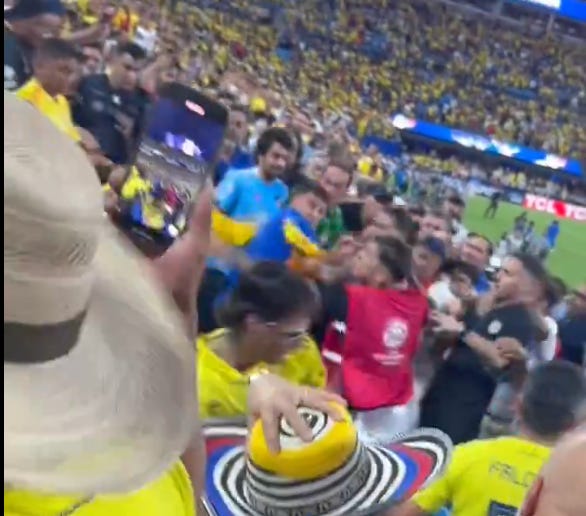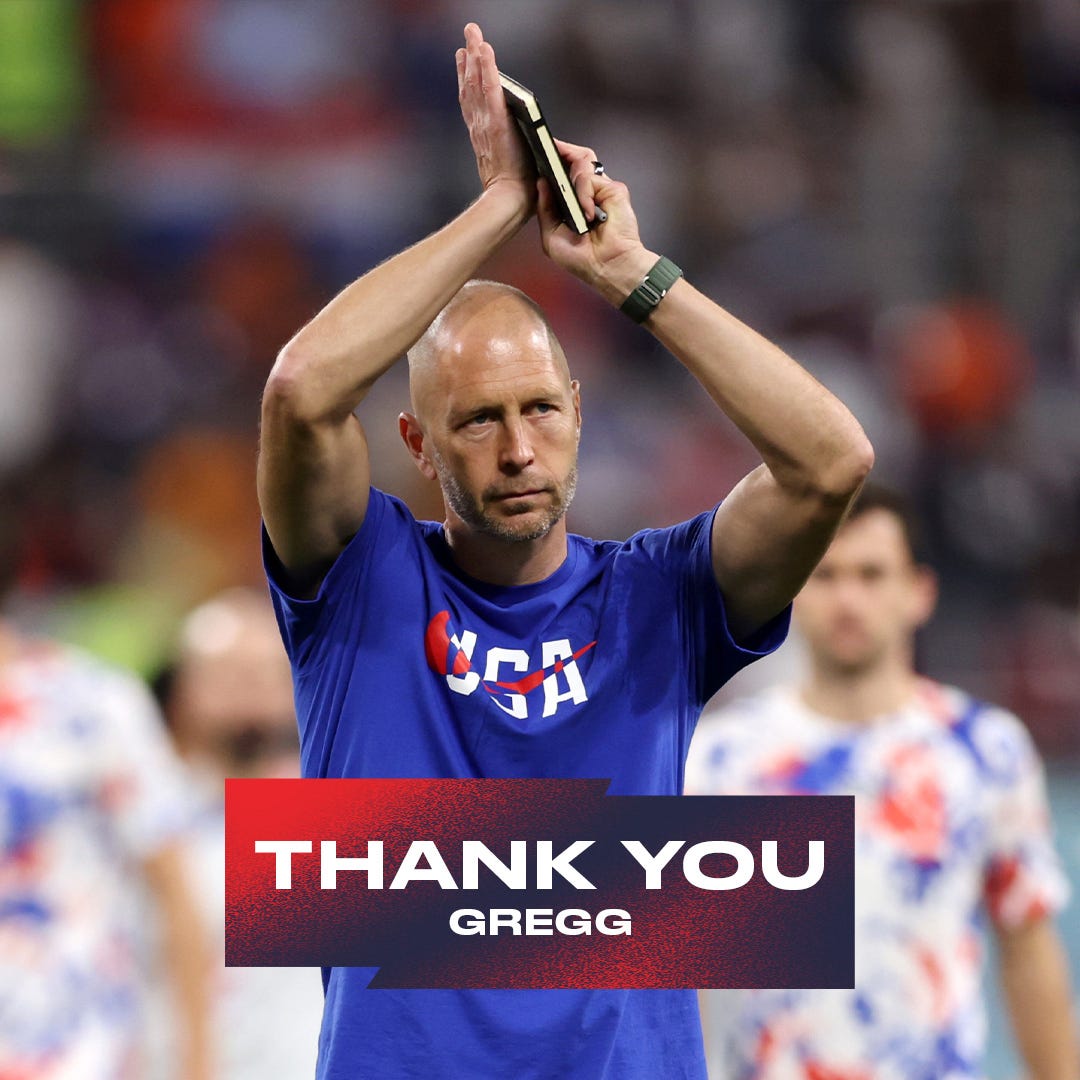🇨🇴 Colombia shows it's more than flair in tight win over Uruguay to reach Copa América final
PLUS: Fighting in the stands and Gregg Berhalter makes way
Hello and welcome! Today we look at what Colombia did right to get to the Copa América final, I share my take about Uruguay players fighting fans, and close out with thoughts about now-former U.S. manager Gregg Berhalter’s firing.
All tournament, Colombia has been about fun, about flair, about us seeing that gorgeous yellow jersey, backed by thousands of fans wearing the same shirt in the stands, fly over the field in coordinated attacking movement.
It’s been about James Rodriguez turning the clock back to 2014, pulling the strings and setting up his talented teammates for goals.
So it was obvious in the 62 minute, when Rodriguez came off along with Richard Rios, that this game wasn’t going to be like the others for Colombia. Attack wasn’t much of an option. Rodriguez had received a yellow in the 55th minute for questioning Mexican referee Cesar Ramos, the same official who dropped Colombia to 10 men as he sent off Daniel Muñoz just before the halftime break.
Plus, he’d already played his part, again using that exemplary left foot to deliver a perfect corner kick headed in by Jefferson Lerma in the 39th minute.
They were going to have to see off another half-hour of Uruguay’s attacks, their variations, the grit and desire of the national team that may have more grit and desire than any other in the world.
“Honestly it was such a tough game,” Colombia manager Nestor Lorenzo said after. “Uruguay is an excellent team with great players, with a manager I really admire. I think we had the match - not controlled because we know there are players who don’t need a lot of build up to make things difficult for you. But we were on the front foot.
“We were brave, even when we went a man down we left two forwards on the field to always have the chance to hit. I think that was an act of courage that God rewarded us for.”
Even if the Lord himself appreciated Luis Diaz’s presence on the field, Colombia needed more than simply the act of leaving attackers in to see out the result. From the hour mark on, Uruguay had seven shots as it continued to try and find an equalizer that would’ve sent the game into a penalty shootout.
It was time for the defense to shine. Unlike the front line, the back line isn’t full of star names.
Then again, it might not be so different. Just as Rodriguez has found the form that launched him to fame, 28-year-old center back Davinson Sanchez seems to be the player he was a few years ago when he was strong enough to anchor Tottenham Hotspur’s back line. Next to him is the consistent Carlos Cuesta. They were joined off the bench by Santiago Arias and Yerry Mina.

Camilo Vargas, the goalkeeper, is a mainstay but never played at a club outside Latin America.
And Colombia certainly knew how to match Uruguay’s physicality. The game was fiery. Before he even blew the opening whistle, Ramos knew he was going to have his hands full. There were punches, elbows, rough fouls, moments of deception.
There also were stretches of joy, where Colombia did look like that flair team, the yellow sparks bouncing across the green rectangle and times when Uruguay did the same, hitting the bar or putting together a move totally foreign to its performance in a slog of a quarterfinal against Brazil.
Those attacking moments were the one Colombia needed to repel any way possible and no matter who was in the game and called into action.
“The guys who came into defend did really well. It was a tough game, but it’s a deserved final,” Rodriguez said after the match. “For me, I’ve been here for almost 13 years, wanting this,” he continued, fending off tears. “We’re happy.”
Colombia fans are too, seeing their team in the final for the first time since they won it on home soil in 2001, seeing a team that has avoided defeat in 28 matches and having the belief they can extend that to 29 matches Sunday as a team that is far more than a one-dimensional squad.
A word on that post-match moment
The broadcast was still showing moments on the field, some heated, others heartfelt, but it was clear something was happening off camera. In the post-game show and on social media, we saw scenes of Uruguay players going into the stands and throwing punches at fans in Colombia jerseys.
We later found out they were in the section where Uruguay players’ families and friends had watched the game. Players perceiving their families to be at risk certainly changes the complexion of the situation. We all can understand the reaction to protect, to defend and to do whatever necessary to keep our loved ones from being harmed.
Uruguay defender Jose Maria Gimenez was eloquent in the post-match TV interview, especially given the situation.
“This is a disaster. Our family is at risk,” he said. “We had to get in there like drunks and to get our loved ones out of there including recently born babies. It’s a total disaster. There wasn’t a single police officer. A disaster.
“We’re showing up for our own. Hopefully the people organizing this will have a bit more caution with families, with people around the stadium because the whole match the same thing was happening. Our families are suffering because of people who … don’t know how to drink and then behave like little boys.”
The situation does not, as some fans have argued, give the players carte blanche to act in any way they see fit. Those who crossed the line should be suspended for World Cup qualification matches, and they no doubt will feel it was worth it to do what they felt they needed to do.

Judging from the videos available, I don’t feel there was less security than at a usual match, though I understand why Gimenez would disagree and may think there should be more authority figures present. There are security personnel in the videos trying to break up the fight and trying to get Colombia fans to leave the stadium rather than stick around and bother the Uruguay supporters.
But there is a clear lack of proper security and crowd control procedures in place. If players’ family members are going to be right there in the open (they’re often in a more separated section if not boxes or suites), there needs to be a plan in place for how they’re being protected and how they’re getting out: Win, lose or draw.
There is plenty for CONMEBOL to evaluate after this tournament. The statement released Wednesday night
We also, as fellow fans, need to do what we can to make sure other fans know it’s not cool to fight. We’ve become far too comfortable with people drinking alcohol to the point of losing control, with whipping out phones when we see people start a physical confrontation, maybe even tossing a drink.
To be honest, I really doubt many reading this newsletter are in those categories, but peer pressure is a great motivator. We’ll get the sport we deserve. Let’s all try to be just a bit better.
Gregg’s gone
The big news in Concacaf on Wednesday was the posting of a graphic many fans had been waiting a long time to see.
Gregg Berhalter was fired as U.S. men’s national team manager Wednesday, with a search starting
I wrote about it last week in Kansas City. Berhalter had to go. History may be kind to Berhalter for what the U.S. did in the 2022 cycle and for what so many in the U.S. hope will be remembered as the start line to historically successful World Cup showings in 2026, 2030 and beyond.
But the idea Berhalter had to go became more true as time went on and it became clear just how little faith the fan base had in him. The American Outlaws. Barra 76. Other groups, both those organized and less formal, wrote letters to U.S. Soccer leadership asking for a change to be made.1
It didn’t need to take a fan protest, but sporting director Matt Crocker may have his reasons for moving methodically.
“Our immediate focus is on finding a coach who can maximize our potential as we continue to prepare for the 2026 World Cup, and we have already begun our search process,” Crocker said in the news release.

He’ll need to. While the next game the Americans play with any sort of stakes will be November’s Concacaf Nations League quarterfinals, getting a manager in place by October’s friendly matches should be the minimum goal.
Still, if it were obvious who the next coach should be, the “Thank you, Gregg” would’ve been followed quickly with “Welcome, (name)!”
Instead, we’re all making lists that include candidates who may not answer the phone, even if Crocker tracks down their number and others who are nowhere near ready for a job as big as leading the U.S. into the 2026 World Cup. There are many reasons I’m glad I’m not in charge of U.S. Soccer, but not having to figure out who the managerial savior should be is one of them.
Berhalter joins Heimir Hallgrímsson, who was announced Wednesday as the new Ireland manager after leaving Jamaica, Paraguay manager Daniel Garnero and Ecuador boss Felix Sanchez as managers whose last matches with their national teams took place at the 2024 Copa América.
That is to say, 25% of those who went into the tournament as coaches, an entire group’s worth of managers, have been dismissed after Copa América elimination. And that assumes Jaime Lozano hangs on and isn’t replaced by Javier Aguirre, as is rumored.
Is that too many? Probably not. This tournament is as big as it gets until the 2026 World Cup. If it didn’t go well, now is the time to make a move ahead of the 2026 World Cup.
Last night’s score
Colombia 1-0 Uruguay
Saturday’s big match
Canada v. Uruguay - 8p ET
Sunday’s final
Argentina-Colombia - 8p ET
Even the ‘no politics’ one- no, no I’m just kidding. I think that one petered out.






